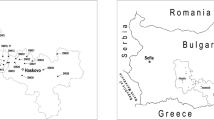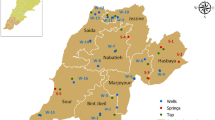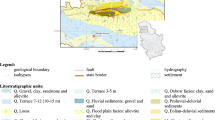Abstract
Radioactivity monitoring programs to check the quality of drinking water are in place in many countries. For routine monitoring of drinking water and especially in case of a radiological emergency, certified reference materials (RMs) are needed to build confidence in the analytical results. A review of potential nonnuclear and nuclear emergencies as sources of exceedingly radioactivity in the environment shows that radionuclides to be targeted by monitoring programs are generally not the same in both emergency types. In each type of emergency, the likely radioelements involved have different chemistry and ionizing radiation emissions. In spite of occasional interlaboratory analytical comparisons for radionuclides in water, exercises and RMs available do not test the full range of radioactive contaminants required. Therefore, there is a need for reference materials suitable for this purpose.


Similar content being viewed by others
References
Achterberg, E. P., Braungardt, C., Morley, N. H., Elbaz-Poulichet, F., & Leblanc, M. (1999). Impact of Los Frailes mine spill on riverine, estuarine and coastal waters in southern Spain. Water Research, 33, 3387–3394.
Brooks, T., Frewin, P., & Thompson, K. C. (2011). Development of a rapid gross alpha and gross beta method for the water industry. In K. C. Thompson & U. Borchers (Eds.), Water contamination emergencies (pp. 125–132). London: RSC.
Camplin, W. C., Baxter, A. J., & Round, G. D. (1996). The radiological impact of discharges of natural radionuclides from a phosphate plant in the United Kingdom. Environment International, 22(1), 259–270.
Carvalho, F. P. (1995). 210Pb and 210Po in sediments and suspended matter in the Tagus estuary Portugal. Local enhancement of natural levels by wastes from phosphate ore processing industry. The Science of the Total Environment, 159, 201–214.
Carvalho, F. P. (2009). The threats and challenges of a radiological emergency. In K. A. Duncan & C. A. Brebbia (Eds.), Disaster management 2009 (pp. 45–53). London: WIT.
Carvalho, F. P., Madruga, M. J., Oliveira, J. M., Lopes, I., Ferrador, G., & Sequeira, M. M. (2008). Naturally-occurring radionuclides in drinking water from surface and groundwater reservoirs. In A. S. Paschoa & F. Steinhaeusler (Eds.), The Natural Radiation Environment (NRE VIII). AIP Conference Proceedings 1034 (pp.224-229). Melville, New York: American Institute of Physics.
Carvalho, F. P., & Oliveira, J. M. (2009). Performance of alpha spectrometry in the analysis of uranium isotopes in environmental and nuclear materials. Journal of Radioanalytical and Nuclear Chemistry, 281, 591–596.
Doi, T., Masumoto, K., Toyoda, A., Tanaka, A., Shibata, Y., & Hirose, K. (2013). Anthropogenic radionuclides in the atmosphere observed at Tsukuba: characteristics of the radionuclides derived from Fukushima. Journal of Environmental Radioactivity, 122, 55–62.
EU (1998). European Union COUNCIL DIRECTIVE 98/83/EC of 3 November 1998 on the quality of water intended for human consumption (OJ L 330, 5.12.1998, p. 32).
Gascoyne, M. (1992). Geochemistry of the actinides and their daughters. In M. Ivanovich & R. S. Harmon (Eds.), Uranium series disequilibrium. Applications to earth, marine, and environmental sciences (pp. 36–61) (2nd ed.). Oxford: Clarendon.
Hierro, A., Bolivar, J. P., Vaca, F., & Borrego, J. (2012). Behavior of natural radionuclides in surficial sediments from an estuary impacted by acid mine discharge and industrial effluents in Southwest Spain. Journal of Environmental Radioactivity, 110, 13–23.
IAEA (2005). Categorization of radioactive sources. IAEA Safety Standards series, no. RS-G-1.9. International Atomic Energy Agency, Vienna.
IAEA (2013). International Atomic Energy Agency, Reference Products for Environment and Trade. Reference materials on line catalogue. http://nucleus.iaea.org/rpst/ReferenceProducts/ReferenceMaterials/Radionuclides/index.htm. Accessed 22 April 2013
Ilus, E., & Saxén, R. L. (2005). Accumulation of Chernobyl-derived 137Cs in bottom sediments of some Finnish lakes. Journal of Environmental Radioactivity, 82, 199–221.
IRMM (2013). Institute for Reference Materials and Measurements, IRMM Reference materials on line catalogue. http://irmm.jrc.ec.europa.eu/reference_materials_catalogue/catalogue/Pages/index.aspx. Accessed 22 April 2013
Koster H.W. (1989). Radiation doses caused by natural radionuclides in the northeast Atlantic. In: Proceedings of a Seminar on the Radiological Exposure of the Population of the European Community from Radioactivity in North European Marine Waters, Project Marina, Bruges, June 1989, CEC. Luxembourg: Commission of the European Communities. pp. 269–284
Lange, M., & Pilz, N. (2011). Selection and prioritization of substances relevant for intentional drinking water contamination. In K. C. Thompsn & U. Borchers (Eds.), Water contamination emergencies (pp. 88–96). London: RSC.
Masson, O., Baeza, A., Bieringer, J., Brudecki, K., Bucci, S., Cappai, M., Carvalho, F. P., Connan, O., Cosma, C., Dalheimer, A., Didier, D., Depuydt, G., De Geer, L. E., De Vismes, A., Gini, L., Groppi, F., Gudnason, K., Gurriaran, R., Hainz, D., Halldorsson, O., Hammond, D., Hanley, O., Holey, K., Homoki, Z., Ioannidou, A., Isajenko, K., Jancovic, M., Katzberger, C., Kettunen, M., Kierepko, R., Kontro, R., Kwakman, P. J. M., Lecomte, M., León Vintró, L., Leppanen, A. P., Lind, B., Lujaniene, G., McGuinnity, P., McMahon, C., Mala, H., Manenti, S., Manolopoulou, M., Mattila, A., Mauring, A., Mietelski, J. W., Moller, B., Nielsen, S. P., Nikolic, J., Overwater, R. M. W., Palsson, S. E., Papastefanou, C., Penev, I., Pham, M. K., Povinec, P. P., Rameback, H., Reis, M. C., Ringer, W., Rodriguez, A., Rulik, P., Saey, P. R. J., Samsonov, V., Schlosser, C., Sgorbati, G., Silobritiene, B. V., Soderstrom, C., Sogni, R., Solier, L., Sonck, M., Steinhauser, G., Steinkopff, T., Steinmann, P., Stoulos, S., Sykora, I., Todorovic, D., Tooloutalaie, N., Tositti, L., Tschiersch, J., Ugron, A., Vagena, E., Vargas, A., Werhofen, H., & Zhukova, O. (2011). Tracking of airborne radionuclides from the damaged Fukushima Dai-Ichi nuclear reactors by European networks. Environmental Science and Technology, 45(18), 7670–7677.
New York Times (2011). “Regulation lax as gas wells’ tainted water hits rivers.” In New York Times, 27 February, and e-links therein. http://www.nytimes.com/2011/02/27/us/27gas.html?pagewanted=all&_r=0. Accessed 23 April 2013
NIST (2013). National Institute of Standards and Technology, standard reference materials on line catalogue. https://www-s.nist.gov/srmors/. Accessed 22 April 2013
Oliveira, J. M., & Carvalho, F. P. (2006). A sequential extraction procedure for determination of uranium, thorium, radium, lead and polonium radionuclides by alpha spectrometry in environmental samples. (Proceedings of the 15th Radiochemical Conference). Czechoslovak Journal of Physics, 56(Suppl. D), 545–555.
Orsolya, K., Mayes, W. M., Anton, Á. D., Feigl, V., Jarvis, A. P., & Gruiz, K. (2012). Ecotoxicity of fluvial sediments downstream of the Ajka red mud spill, Hungary. Journal of Environmental Monitoring, 14, 2063–2071.
Pennders, R. M. J., Koster, H. W., & Lembrechts, J. F. (1992). Characteristics of 210Po and 210Pb in effluents from phosphate-producing industries: a first orientation. Radiation Protection Dosimetry, 45, 737–740.
Saxén, R. L. (2007). Cesium-137 in freshwater fish and lake water in Finland after the Chernobyl deposition. Boreal Environment Research, 12, 17–22.
Stractchan, C. (2002). Review of tailings dam incident data. Mining Environment Management : 7–9.
UNSCEAR (1988). Sources and effects of ionizing radiation. United Nations Scientific Committee on the Effects of Atomic Radiation, Report to the General Assembly, New York
USEPA (2013) United States Environmental Protection Agency. http://www.epa.gov/radiation/tenorm/oilandgas.html. Accessed 22 April 2013
WHO (2004). Guidelines for drinking water quality, 3rd edn, Vol. I. Recommendations. Geneva: World Health Organization (ISBN 92 4 1546387).
WISE (2013). WISE Uranium Project. Uranium dam failures. http://www.wise-uranium.org/mdaf.html. Accessed 22 April 2013
Author information
Authors and Affiliations
Corresponding author
Rights and permissions
About this article
Cite this article
Carvalho, F.P., Fajgelj, A. Radioactivity in Drinking Water: Routine Monitoring and Emergency Response. Water Air Soil Pollut 224, 1597 (2013). https://doi.org/10.1007/s11270-013-1597-y
Received:
Accepted:
Published:
DOI: https://doi.org/10.1007/s11270-013-1597-y




